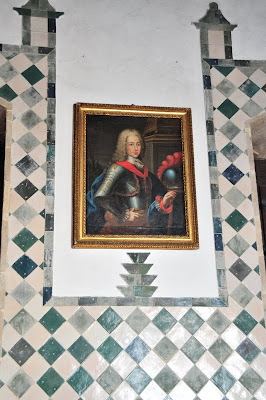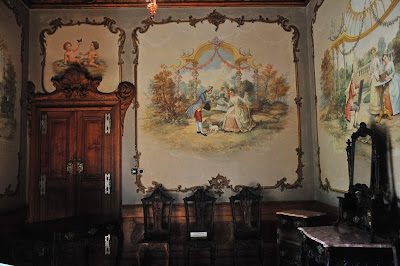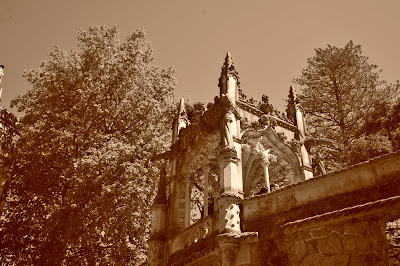The Sintra National Palace is the best preserved mediaeval Royal Palace in Portugal, having been inhabited more or less continuously from the early 15th to the late 19th century. It is part of the Cultural landscape of Sintra and designated a World Heritage Site by UNESCO.
Untitled Portait in the Swann's Room
The history of the National Palace goes back to the times of Islamic domination, when Sintra had two different castles. One of them, located on top of a hill overlooking Sintra is the so-called Castle of the Moors (Castelo dos Mouros), which is now a romantic ruin. The other, located downhill, was the residence of the Moorish rulers of the region. Its first historical reference appeared in the 10th century by the Arab geographer Al-Bacr. In the 12th century, when the village was conquered by King Afonso Henriques, the King took the residence in his possession. The mixture of Gothic, Manueline and Moorish styles in the present palace is, however, mainly the result of building campaigns in the 15th and early 16th centuries.
The Castle of the Moors
Nothing built during Moorish rule or during the reign of the first Portuguese kings survives. The earliest surviving part of the palace is the Royal Chapel, possibly built during the reign of King Dinis I in the early 14th century. Much of the palace dates from the times of King John I, who sponsored a major building campaign starting around 1415.
The Central Courtyard
Most buildings around the central courtyard - called the Ala Joanina (John's Wing) - date from this campaign, including the main building of the façade with the entrance arches and the mullioned windows in Manueline and Moorish styles (called ajimezes), the conical chimneys of the kitchen that dominate the skyline of the city, and many rooms including:
The Swann's Room (Sala dos Cisnes) in Manueline style, named so because of the swans painted on the ceiling.
The Ceiling in the Swann's Room
Pegas' Room (Sala das Pegas); the magpies (pegas) painted on the ceiling and the frieze hold the emblem por bem (for honour) in their beaks. This relates to the story that the king John I was caught in the act of kissing a lady-in-waiting by his queen Philippa of Lancaster. To put a stop to all the gossip, he had the room decorated with as many magpies are were women at the court.
The Magpie Room
Arab Room (Sala dos Árabes)
Alicatados Tiles in the Arab Room
John I's son, King Duarte I, was very fond of the Palace and stayed long periods here. He left a written description of the Palace that is very valuable in understanding the development and use of the building, and confirms that much of the palace built by his father has not changed much since its construction. Another sign of the preference for this Palace is that Duarte's successor King Afonso V was born (1432) and died (1481) in the Palace. Afonso V's successor, King John II, was acclaimed King of Portugal in the Palace of Sintra.
16th Century
The other major building campaign that defined the structure and decoration of the Palace was sponsored by King Manuel I between 1497 and 1530, using the wealth engendered by the exploratory expeditions in this Age of Discoveries. The reign of this King saw the development of a transitional Gothic-Renaissance art style, named Manueline, as well as a kind of revival of Islamic artistic influence (Mudéjar) reflected in the choice of polychromed ceramic tiles (azulejos) as a preferred decorative art form.
King Manuel ordered the construction of the so-called Ala Manuelina (Manuel's Wing), to the right of the main façade, decorated with typical manueline windows. He also built the Coats-of-Arms Room (Sala dos Brasões) (1515–1518), with a magnificent wooden coffered domed ceiling decorated with 72 coats-of-arms of the King and the main Portuguese noble families. The coat-of-arms of the Távora family was however removed after their conspiracy against king Joseph I.
The domed ceiling in the Coat-of-Arms Room
The azulejo tiles
King Manuel also redecorated most rooms of the Palace with polychromed tiles specially made for him in Seville. These multicoloured tile panels bear Islamic motifs and lend an Arab feeling to many of the rooms inside.
The courtyard
Main courtyard of the Sintra Palace with a Mudéjar-style mullioned windows and portal and 16th-century geometrical tile decoration. King Manuel also redecorated most rooms of the Palace with polychromed tiles specially made for him in Seville. These multicoloured tile panels bear Islamic motifs and lend an Arab feeling to many of the rooms inside
A bedroom with Arab tiles
The Guest Bedroom
Modern Times
In the following centuries the Palace continued to be inhabited by Kings from time to time, gaining new decoration in the form of paintings, tile panels and furniture. A sad story associated with the Palace is that of the mentally unstable King Afonso VI, who was deposed by his brother Pedro II and forced to live without leaving the Palace from 1676 until his death in 1683.
Tapestry from Flanders
The ensemble suffered damage after the 1755 Lisbon Earthquake but was restored in the "old fashion", according to contemporary accounts. The biggest lost to the great earthquake was the tower over the Arab Room, which collapsed. At the end of the 18th century, Queen Maria I redecorated and redivided the rooms of the Ala Manuelina.
During the 19th century, Sintra became again a favourite spot for the Kings and the Palace of Sintra was frequently inhabited. Queen Amélia, in particular, was very fond of the Palace and made several drawings of it. With the foundation of the Republic, in 1910, the Palace became a National Monument. In the 1940s, it was restored by architect Raul Lino, who tried to return the Palace to its former splendour by adding old furniture from other palaces and restoring the tile panels. It has been an important historical tourist attraction ever since.
The Chapel
Founded by Dom Dinis at the beginning of the 14th century, the Palatine Chapel is evocative of the Holy Spirit, whose devotion was started in Portugal by Queen Santa Isabel. In 1470, Dom Afonso V ordered from the famous painter Nuno Gonçalves, an altarpiece for the high-altar, based on the theme of Pentecost. This altarpiece was lost and substituted, at the end of the 16th century, by another made by Diogo Teixeira, also lost. Only a painting on the same theme can, nowadays, be seen at the Museu de Odrinhas in Sintra.
This religious Christian space is another example of the cross-cultural character of this building. Marked by the mudejarismo, throughout the centuries, many features of Muslim architecture and decorative arts kept being used during the Christian period. This can be testified by the carved wooden lace of the alfarge, or “knotwork”, ceiling and by the paved ceramic floor made of alicatados, both dated to the 15th century.
Although being part of the restoration work carried out on the third decade of the 20th century, the fresco paintings on the walls include vestiges of the original 15th century paintings, visible over the altar, on the left side of the nave and on both sides of the high-altar. The doves, depicted on a pink background, each carrying an olive branch in its beak, are a symbol, both of the Holy Spirit and of the renewal of God’s alliance with mankind, after the flood.
King Afonso VI's Bedroom
In the area corresponding to the former 14th century Palace, ordered by Dom Dinis, this room was used as a prison, in which King Dom Afonso VI lived for nine years, by the order of his brother (the future Dom Pedro II). The deposed king would eventually die in 1683, always in the company of his faithful valet who, according to tradition, slept in the small cubbyhole, connected to his room.
Carlos II’ ambassador in Portugal made comments on the room, saying it looked “more for a burial than to live in”.
Here is one of the oldest medieval pavements in the Palace and in the country, probably made during the works that took place during Dom Afonso V’ reign, in the middle of the 15th century. The pavement is formed by corda-seca tiles of several patterns, decorated with a mudéjar geometric lace, made in Seville, alternated with alicatado bars, probably locally manufactured. In spite of tradition saying the pavement is worn by the unfortunate king’s constant walking from his bed to the window, truth is the tiled pavement was already two centuries old, when the king was imprisoned here
The Kitchen
During the works ordered by Dom João I, at the beginning of the 15th century, the Kitchen was built as an independent part of the construction, to prevent fire and smoke from reaching the noble areas of the Palace. Before long, the Palace Kitchen was famous for her thirty-three metres high chimneys which became the ex-libris of Sintra. There are other examples of conical or pyramidal chimneys in Europe (Pamplona, Iranzu, Fontevrault among others), but the originality of Sintra’s chimneys comes from being double.
The Kitchen was equipped with a series of wood cookers attached to the western wall, and two big ovens. The abundance of water coming from the springs up Sintra hills and piped into a system of containers, made the cooking and the cleaning easier. In the 18th century, the iron cupboard on the wall was set. It was an heating device to keep the plates warm, till they were served in the Palace rooms.
The Kitchen’s dimensions and its chimneys could have had, not only an ostentatious intention, but also the motive of the frequent banquets in which game was served, since it was abundant in Sintra hills. The Royal Family and its court used to go hunting very often and this was one of the main reasons for their stays in Sintra, throughout the centuries.
The white tiles covering the walls are from the end of the 19th century, contemporary to the composition with the royal coat of arms of Portugal and Casa de Sabóia , Dona Maria Pia’s arms, which was made in 1889.
Six centuries after, and with all due safety restrictions, the Palace Kitchen is still used as a supporting area, for the banquets that occasionally take place at the Palace.
Salle de Manuelina
The Salle de Manuelina with porcelain from the 18th century










































































